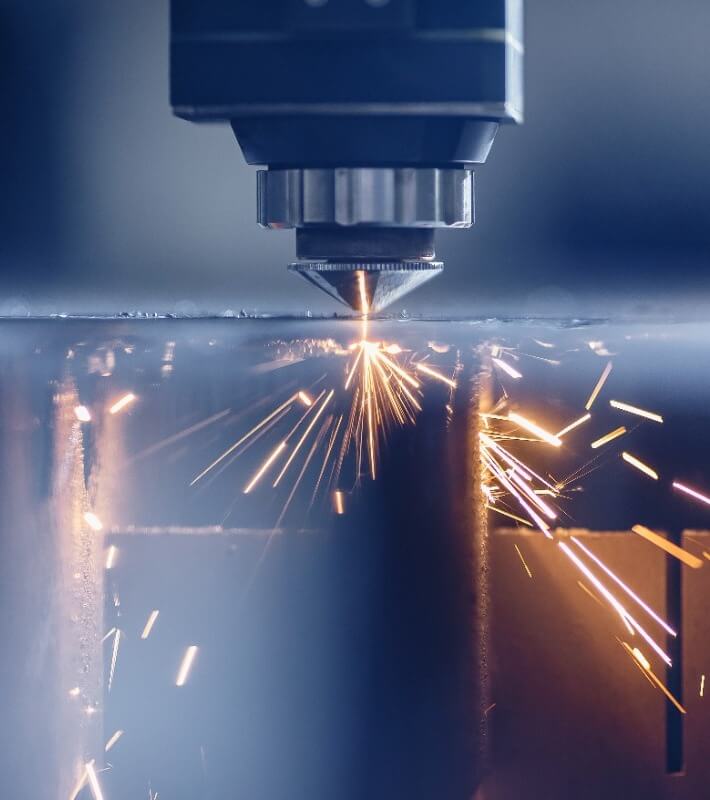Advanced Gas Leak Detectors: Infrared & Gas Sensors
At present, high progress in optoelectronics technology, especially designed for infrared wavelength region (IR), is observed. VIGO Photonics, offering IR detectors, has a great input in the progress. The devices made by VIGO Photonics are not only used in the scientific experiments but they are often crucial elements in industry technologies, mostly in gas analysis systems employing the phenomenon of the optical radiation absorption.
Leak detection of common gases usually deals with a flammable or explosive gas. It means that traditional (i.e., catalytic) leak detection methods are insufficient to successfully detect a leak of a particular gas type.
There is no ideal gas transmission or resource tightness. It means that all gas resources or transmission lines have to be monitored in terms of a gas leakage. Beside traditional gas leak detectors, infrared and laser spectroscopy methods can be used to detect extremely flammable gases. Infrared photon detectors are the major part of the spectroscopy devices. In all spectroscopy gas sensing methods, the infrared detectors can be used.
The use of various spectroscopic methods allows obtaining detailed information on the chemical analysis of the leaking gas. Each of the spectroscopy methods is dedicated to different types of concentration measurements. VIGO infrared detectors operate in the wavelength range of 2–16 μm. The wide range of wavelengths allows for the appropriate adjustment of the selected detector sensitivity to the detected gases in the appropriate wavelength range.

Gas spectra with separated lines of the oscillation and rotation can be observed for light particles. In the case of complex polyatomic molecules, usually the oscillation-rotation structure of the spectra is very complex and because of broadening the individual lines overlap and a continuous band is observed. For some gases particularly relevant for emission and process control, it is necessary to use the mid-infrared range (MIR, 3 µm - 12 µm). This is due to the fact that the gas of interest (e.g., sulfur dioxide, SO2) has no absorption lines in NIR or, in the case of nitric oxide (NO) and nitrogen dioxide (NO2), the absorption strength is too low in NIR (in MIR it is up to 1000 times stronger).

Figure 1. General laser absorption spectroscopy schematics.
Tunable diode laser absorption spectroscopy
Among the methods of gas analysis, techniques using laser and LED sources are currently the most popular. They ensure a very good signal-to-noise ratio and high selectivity of the radiation used. These solutions are used to detect one selected gas. The most popular systems in this group, such as TDLAS, are characterized by a relatively simple design, very high speed of operation and sensitivity sufficient for many applications. In search of the highest parameters, customers choose CRDS instruments offering detection of even trace concentrations of gases, but, in return, they require high system stability during the measurement.
Tunable Diode Laser Absorption Spectroscopy (TDLAS) is a method used for measuring the concentration of a gas or gas mixture. TDLAS allows to measure a very low concentration of the measured gas (up to ppb). At the same time this method allows to measure temperature, pressure, velocity and mass flux of the gas. The method features are fast response and very high sensitivity.

Figure 2. TDLAS working principle schematics.
Beside the laser diode sources, infrared photon detectors are commonly used in a TDLAS gas analysis. All features of TDLAS can be maintained by the fast and sensitive photovoltaic VIGO detectors. Below you can find infrared detectors recommended for the TDLAS gas detection systems. Detector spectral characteristics must be selected for your gas absorption line.
Table 1. Selected spectral characteristics for the gas absorption line.
| Gas type | Selected absorption line [μm] | Suitable VIGO Photonics detector | |
| Water vapor | 2.9, 6.3 | PV/PVA-xTE-3, PV-xTE-6, AM03120-01 | |
| CO2 | 4.26, 9.4 | PV/PVA-xTE-5, PV-xTE-10.6 | |
| NH3 | 10.74 | PV-xTE-10.6, PVM-xTE-10.6 | |
| HCl | 3.5 | PV/PVA-xTE-4, AM03120-01 | |
| HF | 2.5 | PV/PVA-xTE-3 | |
Cavity absorption spectroscopy
Thanks to methane detection spectrometers based on the CRDS method, it is possible to study natural gas leaks even at a very early stage. Cavity ring-down spectroscopy (CRDS) is a highly sensitive optical spectroscopic technique enabling the measurement of an absolute optical extinction by samples scattering and absorbing light. It has been widely used to study gaseous samples which absorb light at specific wavelengths, and, in turn, to determine mole fractions down to the parts per trillion level (ppt).
In particular, devices such as methane detection spectrophotometers based on the said method are used for: monitoring gas transmission lines, analysing defective pipes, forecasting leakages and repairs, risk mapping, emission reduction processes.

Figure 3. CRDS working principle schematics.

Figure 4. CEAS working principle schematics.
The principle of Cavity Enhanced Absorption Spectroscopy (CEAS) method is based upon a measurement of the decay time of a radiation trapped in an optical resonator with a high quality factor.

Figure 5. Detailed CEAS working principle schematics. Left – built up state, right – ring down state.
In the CEAS method, a pulse of laser light is introduced into an optical cavity (resonator) equipped with spherical and highly reflective mirrors. The pulse is reflected multiple times in the resonator. After each reflection, some of the laser light leaves the resonator due to the lack of 100% mirror reflections. Part of the light coming out of the cavity is registered by a photodetector.

Figure 6. Detected radiation on the output of CEAS. ��
Methane testing is possible thanks to a strong absorption line for this gas at a wavelength of 3.31 µm. VIGO Photonics detectors are able to detect concentrations of this gas below 50 ppb ± 0.05%.
Table 2. Detectability of methane by VIGO Photonics detectors.
Gas type
CH4
Selected absorption line [μm]
3.3 l
Analysis technique
CRDS/CEAS
Suitable VIGO Photonics detector
PV-x TE-3, PVA-xTE-3
Gas type
Selected absorption line [μm]
Analysis technique
Suitable VIGO Photonics detector
CH4
3.3 l
CRDS/CEAS
PV-x TE-3, PVA-xTE-3
Practical applications of various gas leak detection
Gas leak detection basic techniques are used as principle methods. They finally have to be applied in end-user practical applications to maintain customer specific requirements. Measurements of gas pipe and natural gas leaks from the ground are the most popular practical applications. Gas leaks could be a static measurement (open path) or on the move - from the sky (air).
Open path spectroscopy has been used to measure hazardous or trace gases from hot point sources such as volcano, industrial, or agricultural facilities. This method is rarely used to measure greenhouse gases from field-scale sources.

Figure 7 . Open Path Laser Detection.
Mobile MWIR gas detection
The mobile laser gas detection method consists in detecting and locating a natural gas leak which is methane. For the gas leakage measurement to be effective, the vehicle must be started and travelled a certain distance, then, a chemical-sensitive detector installed in the device will locate the leak. In this case, the methane analyser is installed on a special vehicle, which, thanks to signal transmitters, transmits information about the increased gas concentration directly to the threat monitoring centre.

Figure 8. Mobile laser gas detection.
Drones with laser spectroscopy detector
Thanks to the development of modern technologies, drones equipped with gas sensors can safely provide detailed information on a natural gas leak. Real-time unmanned aerial vehicles reach gas leaks that are dangerous for humans (drone operator). The advantages of monitoring gas leakage by devices in the air are undoubtedly: their small size, so they can get practically anywhere, ease of use and relatively low operating costs of these devices.


Similar applications
Frequently asked questions
In this section, you can read about the most frequently asked questions and answers about VIGO Photonics products.
Can you explain the significance of detectors in spectroscopy systems and their contribution to accurate data analysis?
In spectrometers, light carries all the information about molecular composition of the analyzed sample. Therefore the detector must be up to the challenge with its parameters. High sensitivity of the detector enables the spectroscopy systems to be more precise in distinguishing different substances and assessing their concentration. Short time of response - i.e. small time constant - contributes to data being analyzed in real time, without any delays. Well-designed detector electronics help in convenient and noise-free acquisition of signal from the detector.
How does an IR spectroscopy detector operate, and what are the key principles behind its functionality in analyzing molecular structures?
The detector operates on a simple principle - it converts IR radiation into an electric signal. The amount of signal generated per unit of optical power is called responsivity and is one of the main metrics by which the detectors are classified. The higher the responsivity, the lower signals can be detected. For the end user that means that lower concentrations of given molecules can be detected.
What distinguishes infrared spectroscopy from other spectroscopic techniques, and how are specialized detectors designed for IR applications?
In IR spectroscopy, light is absorbed by the molecules in a pattern given by each molecule’s infrared spectrum. It consists of specific lines corresponding to rotational-vibrational levels of the molecule and tells us which specific wavelengths are absorbed by which molecule type. The detectors are therefore designed to register wavelengths in which infrared absorption spectra are located. Normally, this range is between 1 and 16 um wavelengths (MWIR + LWIR).
What is the fundamental concept behind IR spectroscopy, and how does it utilize detectors to identify and characterize different compounds?
In IR spectroscopy, light is absorbed by the molecules in a pattern given by each molecule’s infrared spectrum. It consists of specific lines corresponding to rotational-vibrational levels of the molecule and tells us which specific wavelengths are absorbed by which molecule type. The detectors are therefore designed to register wavelengths in which infrared absorption spectra are located. Normally, this range is between 1 and 16 um wavelengths (MWIR + LWIR).
In the context of IR spectroscopy, what precisely is the role of detectors, and how do they contribute to the overall efficiency of the analysis process?
In IR spectroscopy, the analyzed sample is illuminated with IR radiation. Registering and interpreting changes in this radiation can lend information about molecular composition of the sample. For this exact purpose - registering of IR radiation - IR detectors are used. As all the information is carried by the IR light, the detector has to be of the highest class to retrieve every bit of data.
Load more











